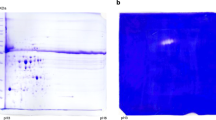Summary
Gel electrophoretic analysis revealed marked alterations in the pattern of acid-extractable proteins from tomato leaves after infection with a viroid (PSTV), two viruses [tobacco mosaic virus (TMV) and cucumber mosaic virus (CMV)], and a fungus(Cladosporium fulvum) when compared to the pattern from healthy leaves. A pathogen-specific appearence of new protein bands was only found after infection with TMV (MW 17,400 and 65,000), CMV (MW 9000 and 8000) andCladosporium fulvum (MW 28,000). With the exception of the TMV coat protein (MW 17,400) it could not be established whether the other four proteins are coded for by the corresponding pathogen or by the host. Nine proteins with the apparent MW of 10,000, 11,000, 12,000, 13,000, 14,000, 25,000, 31,000, 33,000 and 38,000 showed an increase in their relative concentration which is most dramatic in the case of the protein with the MW of 14,000 called p14. A decrease was observed in four proteins with molecular weights of 14,500, 23,000, 30,000 and 105,000. Since all these alterations could be correlated with the severity of the disease symptoms but not with the nature of the pathogen they must be considered as a general pathophysiological response of the tomato plant to infection and symptom development. A partial purification of the most prominent “pathogenesis-related” protein p 14 from tomato plants is described.
Similar content being viewed by others
References
Adam, L. D., Sammons, D. W.: A unique silver staining procedure for color characterization of polypeptides. In:Allen, R. C., Arnaud, P. (eds.), Electrophoresis 1981, 155–165. Berlin-New York: Walter de Gruyter 1981.
Antoniw, J. F., Ritter, C. E., Pierpoint, W. S., van Loon, L. C.: Comparison of three pathogenesis related proteins from plants of two cultivars of tobacco infected with TMV. J. gen. Virol.47, 79–87 (1980).
Barritault, D., Expert-Bezancon, A., Guering, M. F., Hayes, D.: The use of a acetone precipitation in the isolation of ribosomal proteins. Eur. J. Biochem.63, 131–135 (1976).
Branch, A. D., Robertson, H. D., Dickson, E.: Longer-than-unit length viroid minus strands are present in RNA from infected plants. Proc. Natl. Acad. Sci. U.S.A.78, 6381–6383 (1981).
Camacho Henriquez, A., Sänger, H. L.: Gelelectrophoretic analysis of phenolextractable leaf proteins from different viroid/host combinations. Arch. Virol.74, 167–180 (1982).
Conejero, V., Semancik, J. S.: Exocortis viroid: alteration in the proteins of Gynura aurantiaca accompanying viroid infection. Virology77, 221–232 (1977).
Coutts, R. H. A.: Alterations in the soluble protein pattern of tobacco and cowpea leaves following inoculation with tobacco necrosis virus. Plant Sci. Lett.12, 189–197 (1978).
Davies, J. W., Kaesberg, P., Diener, T. O.: Potato spindle tuber viroid. XII. An investigation of viroid RNA as a messenger for protein synthesis. Virology61, 281–286 (1974).
de Witt, P. J. G. M., Bakker, J.: Differential changes in soluble tomato leaf proteins after inoculation with virulent and avirulent races ofCladosporium fulvum (syn. Fulvia fulva). Physiol. Pl. Pathol.17, 121–130 (1980).
Farkas, G. L.: Senescence and plant disease. In:Horsfall, J. G., Cowling, E. B. (eds.), Plant disease, Vol. III, 391–412. New York: Academic Press 1978.
Gianinazzi, S., Ahl, P., Cornu, A., Scalla, R.: First report of host “b” protein appearance in response to a fungal infection in tobacco. Physiol. Pl. Pathol.16, 337–342 (1980).
Grill, L. K., Negruk, V. I., Semancik, J. S.: Properties of the complementary RNA sequences associated with infection by the citrus exocortis viroid. Virology107, 24–33 (1980).
Gross, H. J., Domdey, H., Lossow, C., Jank, P., Raba, M., Alberty, H., Sänger, H. L.: Nucleotide sequence and secondary structure of potato spindle tuber viroid. Nature273, 203–208 (1978).
Gross, H. J., Liebl, U., Alberty, H., Krupp, G., Domdey, H., Ramm, K., Sänger, H. L.: A severe and a mild potato spindle tuber viroid isolate differ in three nucleotide exchanges only. Biosci. Rep.1, 235–241 (1981).
Hall, T. C., Wepprich, R. K., Davies, J. W., Weathers, L. G., Semancik, J. S.: Functional distinctions between the ribonucleic acids from citrus exocortis viroid and plant viruses: cell-free translation and aminoacylation reactions. Virology61, 486–492 (1974).
Haseloff, J., Symons, R. H.: Chrysanthemum stunt viroid: primary and secondary structure. Nucleic acids Res.9, 2741–2752 (1981).
Konarska, M., Filipowicz, W., Domdey, H., Gross, H. J.: Binding of ribosomes to linear and circular forms of the 5′-terminal leader fragment of tobacco mosaic virus RNA. Eur. J. Biochem.114, 221–227 (1981).
Kozak, M.: Inability of circular mRNA to attach to eukaryotic ribosomes. Nature280, 82–85 (1979).
Maizel, J. V., jr.: Polyacrylamide gel electrophoresis of viral proteins. In:Maramorosch,K., Koprowsky H., (eds.), Methods in Virology, Vol. V, 179–246. 1971.
Matthews, R. E. F.: Are viroids negative-strand viruses? Nature276, 850 (1978).
Oakley, B. R., Kirsch, D. R., Morris, N. R.: A simplified ultrasensitive silver stain for detecting proteins in polyacrylamide gels. Analyt. Biochem.105, 361–363 (1980).
O'Farrell, P. Z., Goodman, H. M., O'Farrell, P. H.: High resolution two-dimensional electrophoresis of basic as well as acidic proteins. Cell12, 1133–1142 (1977).
Owens, R. A., Diener, T. O.: RNA intermediates in potato tuber viroid replication. Proc. Natl. Acad. Sci. U.S.A.79, 113–117 (1982).
Rohde, W., Sänger, H. L.: Detection of complementary RNA intermediates of viroid replication by northern blot hybridization Biosci. Rep.1, 327–336 (1891).
van Loon, L. C.: Specific soluble leaf proteins in virus-infected tobacco plants are not normal constituents. J. gen. Virol.30, 375–379 (1976).
Zaitlin, M., Hariharasubramanian, V.: A gel electrophoretic analysis of proteins from plants infected with tobacco mosaic and potato spindle tuber viruses. Virology47, 296–305 (1972).
Zelcer, A., van Adelsberg, J., Leonard, D. A., Zaitlin, M.: Plant cell suspension cultures sustain long-term replication of potato spindle tuber viroid. Virology109, 314–322 (1981).
Author information
Authors and Affiliations
Additional information
With 7 Figures
Rights and permissions
About this article
Cite this article
Henriquez, A.C., Sänger, H.L. Analysis of acid-extractable tomato leaf proteins after infection with a viroid, two viruses and a fungus and partial purification of the “pathogenesis-related” protein p14. Archives of Virology 74, 181–196 (1982). https://doi.org/10.1007/BF01314711
Received:
Accepted:
Issue Date:
DOI: https://doi.org/10.1007/BF01314711




